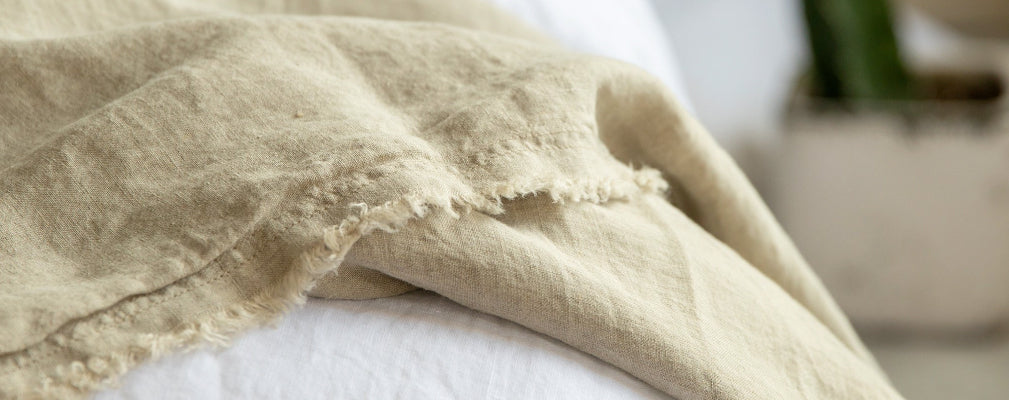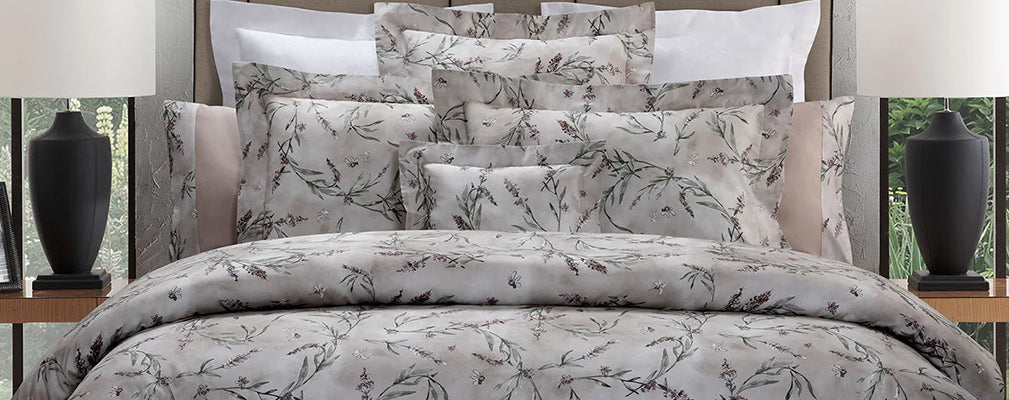Before listing properties and characteristics of linen, let's learn more about this beautiful and valuable fabric.
Linen (Linum usitatissimum) is a natural fiber, composed of 70% cellulose, with a very ancient origin and several properties that make it a truly valuable fabric.
Linen is one of the most durable fabrics in existence due to its cellulosic component, which strengthens its fibers. The not-too-tight weave makes linen fabric breathable, light and cool to the touch. It has insulating and moisture wicking and thermoregulating properties, making it an ideal fiber for both clothing and household linens. It is also called a noble material because being a natural fiber it is hypoallergenic, so it does not irritate the skin or attract dust.
Particularly beloved in the summer season for its lightness, linen is a very versatile noble material that allows for fine linen sheet sets with organic appeal.
Linen is highly valued for its many qualities among which are its versatility, sustainability, being hypoallergenic and breathable, freshness and durability, as well as its unquestionable aesthetic beauty.
Endowed with a very ancient history, today it is mainly produced in Central Europe.
The history of linen
Linen was used as far back as 8,000 B.C., making it probably the oldest fabric in the world.
The ancient Egyptians covered with linen the mummies of pharaohs as a sign of homage, and the Phoenicians exported and traded it in northern Europe.
Later it was used by the Romans as a material for tablecloths and other household items, and its use exploded during the Renaissance, a period in which it was confirmed as a symbol of refinement and elegance, as it is even today.
Linen today is mainly grown and processed in Europe, particularly in France, Belgium and in the Netherlands, which have been awarded the "Master of linen" quality label. This is mainly due to the extremely favorable humid and cold climate, the presence of the most suitable type of soil and the centuries of experience gained by the area's linen farmers.
Characteristics, properties and benefits
Linen is a beloved textile fiber because of its characteristics:
- sustainability: it is an ecological, natural fiber, the cultivation of which enriches the humus of the soil and does not exploit the use of artificial irrigation (rainwater is sufficient) or pesticides; it is also 100% recyclable and biodegradable;
- does not cause allergies: this fabric is in fact hypoallergenic and bactericidal, excellent even on the most delicate skin types;
- resistance: linen is a very durable fiber indeed, which does not deteriorate with repeated washings and does not yellow but rather acquires more softness and gradually becomes whiter;
- thermoregulation: linen is able to give freshness (it is perfect for summer clothes) but at the same time it is able to keep the heat constant (so it is good even in winter);
- breathability: this fabric is able to optimally absorb moisture while allowing the skin to breathe; it is also able to filter UVA rays
Types of linen
Linen is divided mainly into three different types, depending on the fineness of its fiber, which is, in any case, a stiff type (which is why the fabric then appears "wrinkled"):
- fine linens: endowed with a finer fiber, they are perfect for lace, fine yarns and finer cloths, such as cambric;
- middling linens: with a medium fiber size, they are most commonly used for common cloths such as garments, towels and sheets;
- coarse linens: having a thicker fiber, they are generally used for ordinary cloths such as tablecloths or dishcloths.
In addition, the residue of linen processing, i.e. tow, is used to make twine and ropes.
The processing of linen
Linen is composed of fibers that are extracted from a plant, about one meter tall, that has small blue and white flowers that bloom simultaneously on a single day.
- Harvesting: the entire plant is uprooted from the soil in order to be able to get the maximum length of fiber, which is then steeped. The timing of harvesting depends on the thickness of the fiber you want to obtain: if you want a very fine fiber, you will have to weed the plant very early, while it is still tender; conversely, you will wait longer to get a thicker fiber.
- Stripping: the flax fibers are extracted from the bark of the plant, which is husked; woody residues are removed and the fibers are cleaned and combed
- Spinning: next, the fibers are spun through the oldest and most valuable techniques, producing different types of yarn depending on the quality to be obtained
- Ennobling: this term is used to denote certain processes designed to further embellish flax and then market it. They are mainly bleaching, which prepares the fibers for dyeing; dyeing, which is done by soaking the yarn in a solution of water and dye; and sizing, which stiffens the fibers of the fabric.
 |
 |
 |
 |
| Duvet Cover Set in Pure Linen StoneWashed - Luxury | Light Quilt in Pure Cotton StoneWashed - Loira | Bedspread in Pure Linen printed Animals Patterned - Jambo | Towels in Panama Pure Linen - Panamà |









